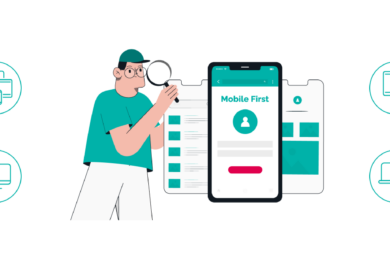
Mobile devices have become the primary way people access the internet, prompting a significant shift in web design philosophy. Mobile-first design, a strategy that prioritizes designing for smaller screens before scaling up to larger ones, has emerged as a best practice in modern web development. In this article, we’ll explore the impact of mobile-first design on the web development landscape and its implications for creating better, more responsive websites.
Evolution of Web Design Philosophy
Traditional web design approaches typically involved creating websites for desktop browsers first and then adapting them for smaller screens. However, the proliferation of smartphones and tablets has led to a fundamental shift in how designers approach web development.
The Rise of Mobile-First Design
Mobile-first design flips the traditional approach on its head by starting with the smallest screen size and progressively enhancing the design for larger screens. This strategy acknowledges the dominance of mobile devices in today’s digital landscape and ensures that websites are optimized for the mobile user experience from the outset.
Key Principles of Mobile-First Design
1. Content Prioritization
Mobile-first design encourages designers to prioritize content and features that are essential for mobile users. This forces a critical evaluation of the website’s content hierarchy and helps streamline the user experience for smaller screens.
2. Performance Optimization
Mobile-first design emphasizes performance optimization to ensure fast load times and smooth navigation on mobile devices. This includes optimizing images, minimizing code, and prioritizing critical content to reduce latency and improve user experience.
3. Responsive Layouts
Responsive design techniques are integral to mobile-first design, allowing websites to adapt seamlessly to different screen sizes and orientations. Flexible grids, fluid layouts, and media queries enable websites to scale and reflow content dynamically based on the user’s device.
4. Touch-Friendly Interactions
Mobile-first design prioritizes touch-friendly interactions to accommodate the unique input methods of mobile devices. Designing larger, tappable elements and avoiding hover-dependent interactions ensure a more intuitive and accessible experience for mobile users.
5. Progressive Enhancement
Progressive enhancement is a core principle of mobile-first design, where designers start with a baseline experience that works on all devices and progressively enhance it with advanced features for larger screens. This ensures that all users receive a functional and accessible experience, regardless of their device or browser capabilities.
Impact on Web Development Practices
The adoption of mobile-first design has had a profound impact on modern web development practices, influencing everything from design workflows to technology choices and performance optimization strategies.
1. Design Workflows
Mobile-first design has shifted design workflows to prioritize mobile considerations early in the process. Designers often start with wireframing and prototyping for mobile screens before expanding to desktop layouts, allowing them to focus on the core content and user experience.
2. Technology Stack
The rise of mobile-first design has led to an increased focus on front-end technologies that support responsive design and performance optimization. Frameworks like Bootstrap, Foundation, and CSS Grid offer robust tools for building responsive layouts, while JavaScript libraries and frameworks like React and Vue.js enable dynamic and interactive user experiences across devices.
3. Performance Optimization
Mobile-first design has heightened the importance of performance optimization in web development. Developers must prioritize techniques like lazy loading, code splitting, and resource caching to ensure fast load times and smooth performance on mobile devices, where bandwidth and processing power may be limited.
4. User-Centric Approach
Mobile-first design encourages a user-centric approach to web development, where designers and developers prioritize the needs and preferences of mobile users. This involves conducting user research, usability testing, and iterative design to create websites that deliver a seamless and intuitive mobile experience.
Conclusion
Mobile-first design has revolutionized the way websites are created, forcing designers and developers to prioritize mobile considerations from the outset. By starting with the smallest screen size and progressively enhancing the design for larger screens, mobile-first design ensures that websites are optimized for the mobile user experience and responsive to the diverse array of devices and screen sizes in use today. Embracing mobile-first design principles enables organizations to create better, more accessible, and more engaging websites that meet the needs of today’s mobile-centric users.








